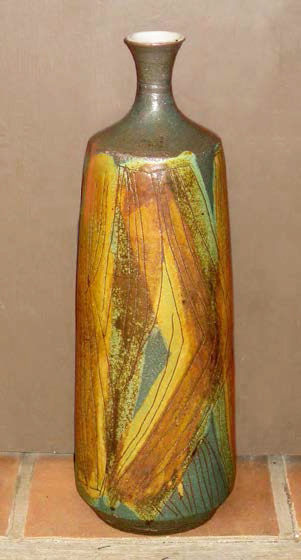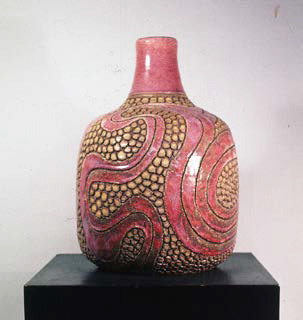Grand Guru of Clay - Page 5
 |
|
|
 |
 |
 |
 |
|
|
Troubled by insomnia, and by back pain that started after a truck plowed into his Jaguar in the mid-1960s, Coronel took uppers to work, then downers to sleep. He drank, even in the studio.
Today he calls himself "a sociopath with a light touch, because I would take a lot of chances in life as well as in the work that I do." He mentions dropping jobs he didn't want to do, and walking away from opportunities. "If it's something I don't like, I won't do it," he says. "You can pay me a million dollars, and I won't do it."
Business fell when Stoneware Designs West had to move from Melrose Avenue in the Design District to a less visible spot to make way for road widening in the late 1960s, Bennett says. "We were out of sight [and] out of mind," he says.
"Designer-craftsmen were doing well for a time," Bennett says, but fell out of fashion in the 1970s.
"Nothing came in as far as commissions," Coronel says. "Business was very bad for everybody."
Lee was struck by cancer in the mid-1980s, at which time Raul stopped making pots. The couple, who had no children, moved to Mexico in 1992 in quest of a promised 'miracle cure,' he says. They lived in a villa near Guadalajara. Raul painted and did silkscreens.
The love of his life died in 1998. He then returned to the Fullerton area, which he regards as home.
Today Raul enjoys life in a senior community, painting, writing a memoir, reading about aircraft and history.
He is enjoying but also annoyed by his newfound fame and by the ever-increasing prices of his old pots. Still, he says of his new fans, "I laud them for having the good sense to buy one of my pieces."
Why did Coronel never make the history books?
"He never worried about historians documenting him, and as a consequence they didn't," Mike Hickman says. And, Hickman notes, Coronel was never part of mainstream academic-ceramic circles.
"He was well represented by interior designers," Hickman says, "but he drew less attention from some of his contemporaries who were associated with schools, who considered his work as decorative or commercial—which to me is just a matter of jealousy, because he was making money and they weren't."
"I was considered commercial," Coronel says. "Dirty word. Commercial."
But what's truly unfortunate is, not only was Coronel forgotten, so were many of his larger works that once decorated halls and boardrooms and stores and lobbies.
In Palo Alto, Lytton Savings is gone, and so is Coronel's mural of Junipero Serra. The 1965 mural for Miles Laboratories in Indiana faced destruction but has been rescued and preserved in the Lerner Theatre, a 1924 cinema palace in Elkhart, Indiana. Elsewhere, many of his works have dropped out of sight.
Coronel hasn't worked in clay since 1986. He recently gave the wheel a try and found he no longer has the wherewithal. Also, he doesn't want to devalue his old work by making something new today, he says.
Raul says he has moved on from clay. But not entirely, perhaps.
"Maybe I'll be one of those guys that ends up in a cloud," he says, "and I'll have a wheel along with me, and using clay from heaven."
• For more information about Raul Coronel and his ceramics, contact the artist at [email protected]
• Michael Hickman's writings about Coronel can be found online at 20thcenturyforum.com/t5623-raul-coronel
Photography: courtesy Raul Coronel, Michael Hickman, Dave Weinstein




